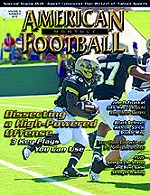Article CategoriesAFM Magazine
|
Strength Report: Practical Movement and Strength Training – The Key to Speedby: Craig SowersAssociate Head Performance Coach, UCLA © More from this issue I have been fortunate, in my 16 years of performance coaching, to have been mentored by the best in the business. Furthermore, I have been privileged to work both at the collegiate level and in the private sector. This allowed me to see things from a different perspective, exposing me to areas such as speed training and leadership/management skills that I wouldn’t have been exposed to had I just stayed at the collegiate level. Although it was a huge risk to leave college athletics, the road less traveled made me twice the strength coach I was before taking the plunge. The combination of experience and maturity has opened my eyes to new ways of training and allowed me to better prepare my athletes for competition. If I were writing this article ten years ago, it would be all about the weight room and what we should be do....The full article can only be seen by subscribers.
|
|
|||||||
| HOME |
MAGAZINE |
SUBSCRIBE | ONLINE COLUMNISTS | COACHING VIDEOS |
Copyright 2025, AmericanFootballMonthly.com
All Rights Reserved





